GUANGZHOU (CANTON)
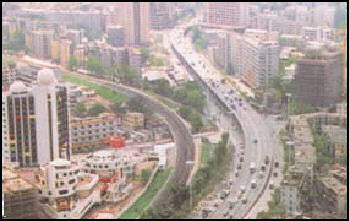
Guangzhou (130 kilometers north of Hong Kong) is China's fifth largest city after Shanghai, Beijing. Chongqing and Tianjin, with 13.2 million people (two thirds of them residents and one third of them migrants). It has long a long history as a trading port and long been regarded as the most Westernized city in China. Trade between China and Europe was largely conducted from here. In the Mao era people picked up Hong Kong radio and television stations and could buy international newspapers on the streets.
Guangzhou is known as a center of liberalism. For more than 100 years, much political change has come from the south, including Sun Yat-sen’s 1911 Republican Revolution, which ended imperial China; the rise of the Kuomintang, which ruled much of China before the Communists took over in 1949; and the Special Economic Zones founded nearby in Shenzhen and Zhuhai in 1979, marking the rise of Chinese capitalism. While Beijing may be the capital of the nation, Guangzhou, southerners say, is "capital of the south."”
Guangzhou (formerly Canton or Kwangchow) is the capital of Guangdong Province and the gateway to southern China. Over 2,000 years old, it lies at the heart of one of the world's busiest and most thriving economic regions: the Pearl River Delta and has close contact with Hong Kong and Shenzhen. Guangzhou is (1,850 kilometers (1,150 miles) south of Beijing and 1450 kilometers (900 miles) southwest of Shanghai.
Metropolitan Guangzhou encompasses an area of over 11,650 square kilometers (4,500 square miles). The city proper has an area of 54 square kilometers (21 square miles). The a population of the city is 11.5 million while the metro area is home to about 24 million people, including several million migrant workers.
See Separate Articles GUANGDONG PROVINCE factsanddetails.com ; GUANGZHOU (CANTON): HISTORY, OPIUM AND ITS PEOPLE AND ECONOMY factsanddetails.com SIGHTS IN GUANGZHOU factsanddetails.com NEAR GUANGZHOU factsanddetails.com ; SHENZHEN: SKYSCRAPERS, MINIATURE CITIES AND CHINA’S FASTEST-GROWING AND WEALTHIEST CITY factsanddetails.com
Tourism in Guangzhou
Guangzhou does not rank that high as a tourism destination. Most visitors to the city either stop briefly or are on their way to somewhere else but that doesn’t mean Guangzhou is not without its charms. It has a few wide tree-lined boulevards and several nice parks. It doesn't have much to offer tourists, though, except a few cheesy sights, good food and restaurants that specialize in snakes and other weird meat dishes.
Virtually nothing from the colonial era or the period when Canton was a great imperial trading port remain.. Guangzhou hosted the Asian Games in October 2010 and is home of the world’s highest Ferris wheel. Along with increased affluence has come increased traffic, construction and pollution. The city is now well-connected by high-speed railroads and subway lines. Progress is been in the high number of flyovers crossing the Pearl River. In preparation for the Asian Games in 2010, a large amount of money was spent on cleaning up Pearl River and creating more green spaces.
Tourist Information: Guangzhou Tourist Information Center, 1/F Equare (Yitai Guangchang), Entrance A or B1 Yuexiu Park Metro Station No. 986 Jiefung Bei Lu, Guangzhou tel. 666-2325. Guangzhou Tourism Bureau, 6/F 180 West Huanshi Rd, 510010 Guanzhou, Guangdong, , China, tel. (0)-20-8666-2769, fax: (0)-20-8666-8083 Web Sites: Wikitravel wikitravel.org ; Life of Guangzhou lifeofguangzhou.com ; official government site english.gz.gov.cn and Travel China Guide ; travelchinaguide.com ; Maps of Guangzhou: chinamaps.org ;
Geography, Orientation and Climate of Guangzhou
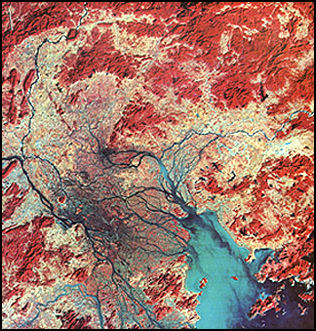
Guangzhou from space
Metropolitan Guangzhou encompasses an area of over 11,650 square kilometers (4,500 square miles). The city proper has an area of 54 square kilometers (21 square miles). Guangzhou metropolitan area includes 10 districts and 2 county-level cities. The filthy Pearl River spits Guangzhou in two and is filled with ocean-going freighters, hydrofoils bound for Hong Kong. and small cargo boats.
The layout of Guangzhou is kind of confusing and a detailed map with names in English and Chinese as well as subways stops and bus routes is helpful. Before you head off to somewhere, it helps to have detailed written directions in both English and Chinese and the name of a landmark near your destination. To get back to your hotel bring a card with the name of your hotel in Chinese and English. Since taxis are cheap, it often worthwhile to take a cab if you don't want to walk. The subway is good and getting bigger all the time. Buses are crowded. There are less bicycles in Guangzhou than in other Chinese cities.
Lying just south of the Tropic of Cancer, Guangzhou has a reasonably pleasant semi-tropical monsoon climate, with long hot and humid summers and mild, overcast winters. August is the hottest month, with an average temperature of 28°C (82°F). January is the coolest month, with an average of 13°C (55°F). Average annual rainfall is around 200 centimeters (77 inches); April and May are the rainiest months. The climate is similar to that of Hong Kong.
Angie Eagan and Rebecca Weiner wrote in “CultureShock! China”: The rainy, hot and humid periods run from April to September, during which time the temperatures can rise as high as 38°C (100°F). Guangzhou winters stay a pleasant 10°C (50°F) to 20°C (68°F), and are three short months: December to February. Guangzhou is in a typhoon corridor from July to September, during which time one can experience forceful rains. In recent years, torrential downpours during the rainy and typhoon periods caused massive flooding and landslides in numerous provinces. The Chinese government have since spared no effort in putting up measures to minimise and curb the aftermath of the downpours. [Source: “CultureShock! China: A Survival Guide to Customs and Etiquette” by Angie Eagan and Rebecca Weiner, Marshall Cavendish 2011]
Crime in Guangzhou
Among Chinese Guangzhou is known for having one of the highest crime rates in China. The crime rate in Guangzhou has soared in recent years, particularly the number of thefts, purse snatching and robberies. Violent crimes such as muggings are also on the rise. Around 100,000 crimes are reported to police; many more go unreported. Bike theft is common. A good quality lock is essential.
The motorcycle thieves in Guangzhou are particularly brazen. In October 2005, a woman that tried to stop motorcycle thieves from stealing her purse had her hand chopped off. Thieves apparently worked for a gang that called itself the Hand Choppers. These and other crimes prompted the city to ban motorcycles from the downtown area of Guangzhou.
Street vendors in Guangzhou do a brisk business selling switchblades, metal rods and other devises intended for protection. When the mayor there told police they needed to get tough on crime, using their weapons f necessary, the police responded by shooting five mugging suspects.
Guangzhou has banned motorcycles and motorized bicycles in many parts of the city mainly as an anti-crime measure. Many Guangzhou residents blame the high crime rates on migrant workers and support capping the number of migrants allowed into the city or allowing only “high quality” ones in the city.
Entertainment and Sports in Guangzhou
Guangzhou has some night clubs, dance halls, video game rooms, bowling alleys, movie theaters and lots of karaoke bars. It is not particularly well-know for its nightlife or cultural activities. The area around Taijin Lu and the Garden Hotel used to be known mostly for its prostitutes, late-night noodle shops and cheap dim sum shops. Now its more of an upscale place with wine bars and fashionable boutiques, popular with affluent Chinese, ex pats and arty types. Guangzhou also has a new Opera House. Many sports facilities were built for the 2010 Asian Games. The China Import and Export Fair (Canton Fair) is a big event. It is usually held in October and April at the Pazhou Complex.
The main nightlife area is Shui Wan Lu (Bar Street), where many bars stay open past the 2:00am closing time, with some staying open until dawn.The Pazhou Complex hosts one of the world’s largest international trade fairs and other events. Venues in Guangzhou occasionally show ballets, symphonies, and plays by touring musical or theatrical groups. Occasional concerts feature Chinese or foreign pop performers. Local movie theaters show dubbed films and some English-language ones. According to “Cities of the World”: “Private lessons in Cantonese and Mandarin language, music, traditional painting, and calligraphy for adults and children are easy to arrange. The growing international business community informally organizes fund-raisers and parties. The American School is a social gathering point, especially for those with children. The Guangzhou Women's International Club is one of the most active groups in the expatriate community, organizing a wide variety of events for its members and guests. [Source: Cities of the World, Gale Group Inc., 2002, adapted from a December 1996 U.S. State Department report]
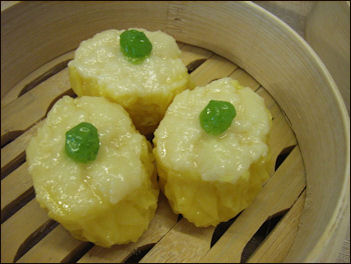
Dim Sum Siu Maai
Ping-pong, badminton, tennis, and tai chi are popular local sports. There are several health clubs near the Consulate and in the major hotels, some of which include swimming pools and squash and tennis courts. The city has several large, modern bowling facilities, as well as good quality indoor roller skating and ice skating rinks operating year round. Basketball and soccer games have been organized at local universities. Horseback riding is available.
Every other Saturday, joggers and walkers may join the local Hash House Harriers at various suburban locations. Guangzhou has several large parks, though they tend to be crowded on weekends. Nearby Baiyun Mountain Park has hiking trails. An 18-hole golf course is located in the northern part of the city. Shenzhen boasts a championship golf course. Other golf clubs are located in the area. Shamian Island is a reasonable location for jogging and is also home to an excellent tennis facility with indoor and outdoor lighted, hard-surface courts.
Cantonese Cuisine
Cantonese cuisine is known for its subtle flavors and fresh ingredients and the lightness and variety of the lightly spiced but colorful dishes, which are often stir-fried to preserve the texture and flavor. Cantonese dim sum and seafood are popular throughout the world. A Cantonese meal can range from a quick snack from a food stall to an elaborate 12-course banquet, featuring delicacies such as shark fin soup, abalone, bird's nest soup, roast suckling pig, and deep-fried prawn paupiette.
Cantonese cooking features a lot of rice and fresh vegetables. Food is parboiled, steamed, or quickly stir fried. The Cantonese love seafood, and freshness is of the utmost importance. According to a popular Cantonese saying "if it doesn't move, we don't eat it." Most seafood restaurants have tanks filled with fish and other sea creatures, with patrons picking out what they want and telling the waiters how they want it prepared. Cantonese prefer their fish steamed, which they say brings out freshness. Fish is also grilled, poached, fried and broiled.
In many ways what the world knows as Chinese food is Cantonese cuisine. Popular Cantonese dishes include sweet and sour pork, shark fin soup, bird's nest soup, barbecued pork ribs, diced chicken with walnuts, slow-cooked soup, roast goose in pickled plums, Cantonese stuffed bean curd,prawns in chili sauce, roast pork ribs, steamed chicken in peanut oil, fried prawns with salt, and diced beef with garlic.
Popular seafood dishes are made with prawns, garoupa (a white, meaty, slightly sweet fish), squid, and octopus. They include fried octopus, steamed prawns in garlic sauce, steamed garoupa with ginger and scallions, fried shrimp balls, baked lobster with cheese sauce, three-colored lobster and dragon and tiger fight. Abalone, crab and lobster are often extremely expensive. Favorite deserts include fresh melon and rice flour coconut balls.
Restaurants in Guangzhou
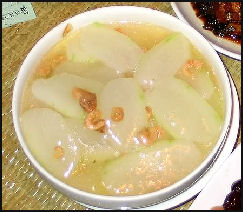
Restaurants are plentiful and good. It is said that the Cantonese spend a third of their income on food. Bustling food markets and busy restaurants are a big part of the Guangzhou street scene. Cantonese cuisine is renowned and local restaurants are packed. The city is famous for its dim sum, seafood and stir-fried dishes made with shrimp, pork, eggplant, noodles, chicken and vegetables. Many travelers make their first stop in Guangzhou the Chinese restaurants on Shamian Island. Many of the best and most expensive restaurants are located in the large hotels. See Shopping Areas Below.
People in Guangzhou are known for their fondness of eating wild animals. The following places have probably either closed down or operate discreetly. The First Village of Wild Food restaurant offered flying foxes and civets — two species posibly linked with SARS and the Coronavirus — small deer, several species of birds, dark-haired pigs and plump rabbits. Most of the animals were kept down stairs in cages. Customers could pick out the animals they wanted and eat it upstairs. Butchers who had tables near the cages quickly killed and skinned the animals which were then prepared by cooks in the kitchen
The Yumin seafood restaurant is a huge place with an of exotic dishes. Crocodiles with their mouths taped shut crawl along the floor. The Sent Down Youth No. 1 Village Wild Flavor Restaurant in Lianbian outside Guangzhou offered herons, snakes, baby deers, flying foxes, and dozens of other species in a dining area decorated with kitschy Mao era posters. Their specialty was “Dragon, Tiger, Phoenix," a stew made with snake, wild cat and crane.
Shopping in Guangzhou
Shopping is a popular pastime in Guangzhou. The antique market is said to be one of best in China. Local markets are busy and stores are stocked with both Chinese and foreign products. Brightly decorated storefronts and brisk trading in noisy markets help create a lively atmosphere in the city. Buildings trimmed in lights and neon signs and billboards illuminate the city at night. The China Import and Export Fair (Canton Fair) is a big event with products from all over China and the world. It is usually held in October and April at the Pazhou Complex. Web Sites : Travel China Guide travelchinaguide.com
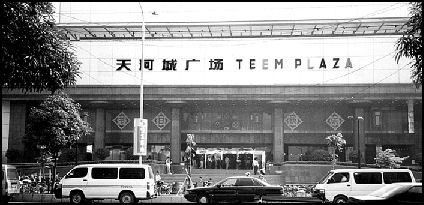
The major shopping streets in Guangzhou are Liu Er San Lu, Dishifu Lu, Remin Lu, Beijing Lu and Zhong Shan Liu Lu. Beijing Road has dozens of upscale clothing and jewelry stores. A large variety of consumer goods are sold on Zhanxi Road and Lian Quian Road. The major shopping areas are: 1) the intersection of Beijing Lu and Zhongshan Lu, the main shopping district; 2) Nafang (near the entrance to Cultural park), the main department store; 3) two Friendship Stores (one near the China Hotel and the other near the Baiyun Hotel); and 4) the Nam Fong International Plaza Shopping Mall (also near the Baiyun Hotel).
Shangxiajiu Pedestrian Street (Liwan District) is a mixed showcase of architecture, cuisine and folk customs.Shangxiajiu Pedestrian Street in Liwan District, Guangzhou, is one of the busiest commercial pedestrian streets in China. Located in the old town of Xiguan, the 1,218-meter-long street is lined with more than 300 shops. Its architecture features the characteristics of south European and Cantonese style, being both functional and aesthetically pleasing. Many tourists are attracted here for its restaurants and food stores, for the street is a good combination of traditional and modern food as well as Chinese and foreign food. Getting There: Take bus No. 38, 31, 103, 823 or 102 and get off at Shangxiajiu Pedestrian Street Station
Qingping Market (on the Pearl River, just north of Shamian Island) sells (or used to sell) turtles, salamanders, snakes, dogs, monkeys, tortoises, foxes, birds, wild boars, pangolins, owls, and giant toads and over 600 varieties of vegetables and meats. There is one merchant that specializes in house cats. Nearby restaurants serve rat, dog and snake.
Xinyuan Market was the largest bird and animal market in Guangzhou but it was shut down in 2004 after the SARS epidemic, which is said to have begun here with the transfer and mutation of the SARS virus from animals to humans. Pigeons, boars, cats, dogs ostriches, rats, civets, badgers, racoons dogs were all sold here. Trucks delivered new batches of animals every day. Many people lived and slept in their small stalls among the caged animals. In the butcher shops spilled blood collected in pools and dogs and other animals were slaughtered and skinned before customers eyes. The animals were often treated horribly. It was not unusual for dogs to arrive on trucks from Henan Province with three animals in a one-by-three-foot cage.
Transportation in Guangzhou
Sights in Guangzhou are scattered the city. Most people get around on foot or by taxi (most use meters). Billions of dollars has been spent on a relatively new underground subway system to relieve congestion brought on by the city's rapid growth. The buses are crowded and difficult to sort out. The Yangchengtong (Yang Cheng Tong) card is a rechargeable smartcard that can be used to pay fares on the metro, buses, taxis and ferries in Guangzhou, Foshan, Huadu, Zengcheng and Panyu. May also be accepted by stores, restaurants, parking meters, banks and other establishments.
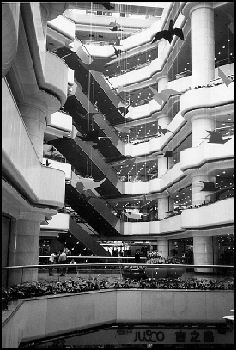
Tianhe Front Shopping Center
Taxis are readily available and foreigners often use them. More drivers speak English here than other Chinese cities still it is a good idea to have your destination written down in Chinese. According to ASIRT: “Fares are inexpensive. Tolls are added to fare. A fuel surcharge is added to fare. A 50 percent surcharge is added for journeys longer than 35 km. Keep receipt; it includes taxi's ID number. Makes recovering items left in taxis easier. Drivers may take circuitous routes and/or give change using counterfeit money.”
In 2008 Guangzhou announced that the number of cars on its roads had reached 1 million (New York had 2 million at that time) and 180,000 new vehicles (nearly 500 a day) hit the city's roads annually, the government said. According to ASIRT: Road risk is high despite improved compliance with driving laws. Speeding is common. Honking is less common than in most larger cities. Traffic is generally congested in central urban from 7:00am-9:00am and 5:00pm-8:00pm. Until familiar with driving conditions in the city, foreign visitors are encouraged to use public transportation during rush hour.
Road mix includes many cyclists. Bike-only lanes are common on larger streets. Traffic in bike lanes may be heavy. Motorcycles, electric scooters and electric bikes are banned in city center. Drivers seldom yield to pedestrians. Use pedestrian bridges. When lacking, cross with caution. Major streets often have 6 lanes or more. Zhongshan Avenue: is heavily traveled but the BRT has reduced congestion and improved safety for motorists and pedestrians. Web Sites: China Highlights
Bicycles in Guangzhou
Bicycling on busy streets or over long distances is are not recommended unless you know what you are doing. On bike riding in Guangzhou, William Foreman of Associated Press wrote: “Cyclists feel themselves being pushed aside. A bike lane near my home is marked with a thick white line, a sign and a bike symbol painted on the pavement. But the line has been chopped up for parking spaces. It's now a bike lane only when motorists aren't using it. Anyway, lanes may as well not exist — drivers seem to think their cars are protected by a force field. And it's not just drivers who are a menace, but pedestrians and even other cyclists. I recently slammed into a migrant worker who blindly pedaled into an intersection. Neither of us was seriously injured, but I badly bruised my hip and wrist as I hit the road and bounced for a few feet. [Source: William Foreman, Associated Press, November 1, 2009]
“While leisure bikes are catching on among Chinese yuppies and college students, few take to the busy streets. Those who do wear helmets, as do I, but we're a tiny subculture. The commuting laborers don't wear helmets. Many of the people behind the wheels of the shiny new cars just got their licenses, and their driving sometimes reminds me of my own in high school. Some drivers are courteous to cyclists, perhaps remembering that they were among them not long ago. But others, especially the nouveaux riches in their Audis and BMWs, show an obvious contempt. They cut off cyclists and deny them the right of way. A honk is usually not a warning to be alert, but a “get out of my way” threat."
“I encountered an extreme example during a training ride with a friend. It was 6:30 a.m. and we were hammering down an empty three-lane thoroughfare at 40 kph when a black Volkswagen Passat behind us opened up with its horn. As it raced beside us we exchanged obscenities until the driver — a beefy man in the kind of crew cut that's popular with police, military and the mob — swerved in front and nearly knocked us down. Few people seem annoyed by Guangzhou's cacophony of car horns. Sometimes drivers seem to be beeping just as a way of saying hello to the weird spandex-clad foreigner."
“Once, while I was barreling through a tunnel, a cement truck rumbled up on my back wheel and the driver started honking. The sound echoing off the tunnel's walls was deafening. Then I saw the driver and another guy in the cab laughing and yelling “Jia you!” It means “Add fuel!” — a Chinese sports cheer. Being tailgated is especially unnerving because roads are so poor. If your skinny racing tires hit a brick or pothole, you can quickly find yourself under a car."
“Construction frenzy keeps the roads under a constant cover of dirt, gravel and debris. Water trucks cruise the streets before rush hour each morning, spraying water to control the dust. But they have no sweeping mechanism, so they leave a slippery layer of gritty mud that clogs expensive bike parts and can bring a cyclist down. Each new pothole must be marked on the cyclist's mental map. Recently after a hard rain, I thought I was speeding through a harmless puddle but it was a hole. It cracked my custom-made bike frame and broke the wheel."
Speed bumps are another hazard. The Chinese authorities love them. Their purpose seems designed not to slow speeders but to punish them. Rarely are they signposted, and they are usually unpainted and hard to see. Near my home, officials have opted for the cheap option — a thick pipe across the road, anchored by roughly cut spikes of rebar that can slice open a bike tire.Perhaps the most hazardous obstacles are created by the midnight mystery dumpers. Their trucks bring construction waste — cement chunks, broken bricks, scraps of dry wall, splintered plywood — to unlit stretches of road and dump the loads where they can easily bring down any unwary biker.
According to ASIRT: “New, tree-lined cycle lanes have improved cycling safety. Lanes link with BRT stops. Bike sharing system is reducing congestion. Can use Yangchengtong card to obtain bike at a bike station, ride to BRT stop and leave bike at nearby bike station. No charge for first hour. Bike lane are available along entire BRT network. Five secure bike parking areas available; most at western end of B1, near Huajing Xincheng, Shangshe, and Xueyuan Stations. Folding bikes are permitted on subways and cross-river ferries, but not on buses. Taxi drivers may allow folding bikes in trunk. Non-folding bikes are only permitted on cross-river ferries. Bike theft is frequent. A good quality lock is essential. Bicycles are not permitted to use in the Zhujiang Tunnel or Zhujiang Suspension Bridge. [Source: Association for Safe International Road Travel (ASIRT), 2011]
Guangzhou Metro and GBRT
The Guangzhou Metro opened in 1997. Guangzhou was the fourth city in Mainland China to have an underground railway system after Beijing, Tianjin, and Shanghai. Currently the Guangzhou metro network has 13 lines, covering a total length of 476.26 km (295.93 mi). It was hoped to expand the system to over 500 km (310 mi) by 2020 with 15 lines. In addition to the metro system there is also the Haizhu Tram line which opened in December 2014. Guangzhou Metro: Wikipedia ; Guangzhou Metro Map: Joho Maps ; China Highlights; Urban Rail urbanrail.net
Guangzhou Tram Map: urbanrail.net
Guangzhou built its extensive subway system very rapidly, most in the late 1990s and 2000s. It had 110 kilometers of subway lines in 2008, most of which opened in the two previous years. An additional 130 kilometers opened in 2009 along with an underground tram and a high-speed commuter rail system. A long term plan calls for at least 800 kilometers of subway and light rails China's first inter-city subway, Guangfo Line, links Guangzhou and Foshan City. Reduces travel time from 90 minutes to 30 minutes. High-speed commuter lines linking Guangzhou, Shunde, Zhongshan, Jiangmen and Zhuhai have been or are being built.
Guangzhou Bus Rapid Transit (GBRT) was introduced in 2010 along Zhongshan Road. It has several connections to the metro and is the world's 2nd-largest Bus Rapid Transit system with 1,000,000 passenger trips daily. Only the TransMilenio BRT system in Bogota is bigger. The system averages one bus every 10 seconds or 350 per hour in a single direction and contains the world's longest BRT stations—around 260 m (850 ft) including bridges.
Sometimes just called the Bus Rapid Transit (BRT), the system is extensive and has helped reduce congestion. According to ASIRT: BRT has 31 routes. Route numbers begin with "B". Route B1 links Tiyu Zhongxin and Xiayuan. Occupies two middle lanes of Zhongshan Avenue. Corridor is separated from other lanes by physical barriers or clear road markings Stations are included in the corridor, and are accessed by pedestrian bridges, at-grade crossings or tunnels. 30 flexible BRT routes run on a section of B1 corridor; remainder of route is on dedicated bus lanes on surface roads. BRT network has 7 transfer stations: Shangshe, Xueyuan, Tangxiacun, Tanlang Mingju, Huangcun, Zhucun and Shida Jida, and is connected to 17 metro stations.
Pay fare with Yangchengtong (Yang Cheng Tong) card. Service is reliable and frequent. Purchase pass before boarding. May be overcrowded, especially during rush hour. BRT's low-floor buses improve accessibility Falling hazard: Be alert when stepping across the 45 centimeter (18 in) gap between bottom step of bus and station platform. Pedestrians and private vehicles are not permitted to use BRT's B1 route. Non-BRT buses use short sections of BRT corridors. Routes generally pass through suburbs. Passengers do not transfer to BRT buses.
Buses and Trains in Guangzhou
According to ASIRT: “Bus service is well developed. Main bus terminals are near train and metro stations, major hotels and universities. Bus stations serving local buses are generally called bus terminals (zongzham). Also called qichezhan, keyunzhan or zhan.City is replacing older, diesel-fueled buses with (liquefied petroleum gas( LPG)-fueled buses. Local buses: Have exact change for fare or pay with Yangchengtong (Yang Cheng Tong) card, a rechargeable smartcard, used to pay fares on metro, buses, taxis and ferries in Guangzhou, Foshan, Huadu, Zengcheng and Panyu. May also be accepted by stores, restaurants, parking meters, banks and other establishments. [Source: Association for Safe International Road Travel (ASIRT), 2011]
The long distance bus station is located on Huanshi Xilu, not far from the main train station. It is big and confusing and has several levels. Inter-city buses have routes to many major cities. Purchase tickets well in advance. Bus service to Hong Kong is readily available. Many leave from major hotels. Cross-border bus stations: Most commonly used station on Hong Kong border is in Lo Wu. Bus station in Zhuhai provides access to Macau.
A new $1.6 billion train station opened in 2008 and serves as a hub for a $16.8 billion high-speed train network that began operation in 2010. According to to ASIRT: China's first inter-city subway, Guangfo Line, links Guangzhou and Foshan City. It reduces travel time from 90 minutes to 30 minutes. Train station staff may not speak English. Carry a phrasebook or travel with a Chinese speaker. Trains link city to Beijing, Shenzhen, Maoming, Meizhou and Shantou. High-speed trains link city with Wuhan. Trains link Guangzhou East railway station and Hung Hom KCR station in Kowloon, Hong Kong. [Source: Association for Safe International Road Travel (ASIRT), 2011]
Major Train Stations: 1) Guangzhou Huochezhan (Guangzhou Railway Station): Trains to many cities and regions. Metro lines 12 and 5 stop at station. 2) Guangzhou Dongzhan (East Railway Station): Trains to Hong Kong and larger cities. Metro line 1 stops at station. 3) Guangzhou Nanzhan (South Railway Station): High- speed trains to border between mainland China and Hong Kong. Metro line 2 stops at station. Transport from station to Lo Wu border crossing is by bus. Service is every hour. 4) Guangzhou North Railway Station is in Huadu District.
Guangzhou Airports
There are five major airports within 130 kilometers of Guangzhou: in Guangzhou, Hong Kong. Macau, Shenzhen and Zhuhai. Baiyun International Airport in Guangzhou opened in August 2004. Located 28 kilometers (17 miles) north of city center in Huadu District, it cost $2.4 billion and has three runways and is able to handle 25 million passengers a year. Baiyun is the second busiest airport in terms of traffic movements in China. It is sometimes called "New Baiyun" to distinguish it from the older, smaller airport it It replaced which was very close to the city centre and in operation for 72 years. Two more runways are planned at the new airport. Terminal 2 opened in 2018. Another airport in Zengcheng District is being planning.
Guangzhou is served by Hong Kong International Airport; ticketed passengers can take ferries from the Lianhuashan Ferry Terminal and Nansha Ferry Port in Nansha District to the HKIA Skypier. There are also coach bus services connecting Guangzhou with HKIA.
Airport to City Transportation in Guangzhou: A light railway connects Baiyin airport to Guangzhou's Metro lines. There are also taxis and buses that use using the airport expressway that connects the Guangzhou-Shenzhen and Beijing-Zhubai highways. Metro Line 3 links the airport, East Railway Station and Tiyu Xilu Metro Station. Service is every seven minutes between 6:00am and 11:00pm.
Airport Express buses leave outside Arrivals Hall. Depart every 10-15 minutes. Open 7:00am until last flight leaves. Lines 1-6 go to central districts; lines 7-11 go to suburbs. Airport shuttle buses serve 8 routes in the metropolitan area. Shuttles also have routes between airport and major hotels. Routes and timetables are available on airport's website: www.cantontradefair.com/ticketing/canairportbus.htm. Direct buses provide transport to larger cities in region. Metered taxis are available outside Arrivals Hall. Avoid using unregistered taxis.
Boats Between Guangzhou, Hong Kong and Mainland China
Water Transport is an important part of Guangzhou transport network. There are daily high-speed catamaran services between Nansha Ferry Terminal and Lianhua Shan Ferry Terminal in Guangzhou and the Hong Kong China Ferry Terminal, as well as between Nansha Ferry Terminal and Macau Ferry Pier in Hong Kong.Ferries to Hong Kong leave from Nansha Ferry Terminal or Lianhua Shan Ferry Terminal. They arrive at China Ferry Terminal in Hong Kong. Ferries to Macau leave from Nansha Ferry Terminal. They arrive at Hong Kong's Macau Ferry Pier. Ferries are available for crossing city's rivers. Boats to Wuzhou from Guangzhou leave from Dashatou Harbor Passenger Terminal. The trip takes 17 hours. The Catamaran from Guangzhou to Wuzhou takes 5 hours.
Hong Kong is linked to several of ports in Mainland China by high-speed boats (ferries) servicing Hong Kong Island, Kowloon and Hong Kong International Airport (off Lantau Island). Travelers planning to visit Zhuhai can obtain 24hr visas at the border, but anyone wishing to stay longer or travel further afield in mainland China will need to apply for a visa in advance from the Chinese embassy in their home country, or through a service in Hong Kong.”
1) Chu Kong Passenger Transport (CKS) provides ferry services between Hong Kong and the Pearl River Delta cities of Macau and Shekou (Shenzhen), Zhongshan, Humen (Dongguan) and Zhuhaicities in Guangdong province of mainland China.
Ferries leave from Hong Kong - China Ferry Terminal
Location: 33 Canton Road, Tsim Sha Tsui, Kowloon
How to get there: MTR Tsim Sha Tsui Station, Exit A1
For information on schedules, routes and fares check the CKS website: https://www.cksp.com.hk/en/route/pearl_river_delta/shipingline_price_hk_zj cksp.com.hk
2) Hong Kong International Airport SkyPier ferry service: The company Sea's Young operates a ferry between Hong Kong International Airport (Skypier) to Humen ferry daily with the trip taking about 1 hour and 20 minutes. Passengers transiting through Hong Kong International Airport on their way to the Pearl River Delta region via SkyPier ferry services do not need to go through immigration and customs or reclaim baggage.
Transportation Between Shenzhen, Hong Kong and Guangzhou
There are about seven ways to get from Hong Kong to China: 1) You can take a Hong Kong train to Lo Wu, cross the border, and catch another train in Shenzhen China; 2) You can take a train from Kowloon (Hong Kong) to Guangzhou (Canton); 3) You can take a catamaran hydrofoil from Hong Kong to Guangzhou or Wunzhu (about 5 hours by bus from Guilin). 4) you can fly; 5) go via Macau; 6) go on the new bridge 55-kilometer-long Hong Kong–Zhuhai–Macau Bridge; or take a bus directly to a destination in China or to the border, cross the border, and take another bus on the other side.
The train that runs between Kowloon and the Chinese border makes about ten stops. It's termination points are the 1) Kowloon-Guangzhou Railway Station in Hunghom on the Kowloon side of the Harbor in Hong Kong and 2) Lo Wu station at the border of China at Shenzhen. Trains to the border run every 10 minutes. From Hunghom station the trip covers 34 kilometers and takes about 40 minutes. Tickets cost about US$7 for a normal seat and US$15 for a first class seat.
Crossing the border generally takes about 30 minutes but can take longer. The Lo Wu border crossing between Shenzhen and Hong Kong is one of the busiest in the world. About 400,000 people cross every day. The border is open from 6:30am to 12:00midnight. There has been a suggestion of opening the border for 24 hours a day.
Once in Shenzhen you can take direct trains to Beijing, Shanghai and Guangzhou. Fast trains between Shenzhen and Guangzhou run every hour The trip take about an hour. You can also take a minibus and a bus to Guangzhou. The trip takes about three hours. There are two daily trains from Shenzhen to Beijing. Train ticket can be purchased at China International Travel Service (CITS) in Hong Kong. See tourist offices for the phone number and address.
Image Sources: Province maps from the Nolls China Web site. Photographs of places from 1) CNTO (China National Tourist Organization; 2) Nolls China Web site; 3) Perrochon photo site; 4) Beifan.com; 5) tourist and government offices linked with the place shown; 6) Mongabey.com; 7) University of Washington, Purdue University, Ohio State University; 8) UNESCO; 9) Wikipedia; 10) Julie Chao photo site
Text Sources: CNTO (China National Tourist Organization), UNESCO, Wikipedia, Lonely Planet guides, New York Times, Washington Post, Los Angeles Times, National Geographic, The New Yorker, Time, Newsweek, Bloomberg, Reuters, Associated Press, AFP, Compton's Encyclopedia and various books and other publications.
Updated in May 2020
